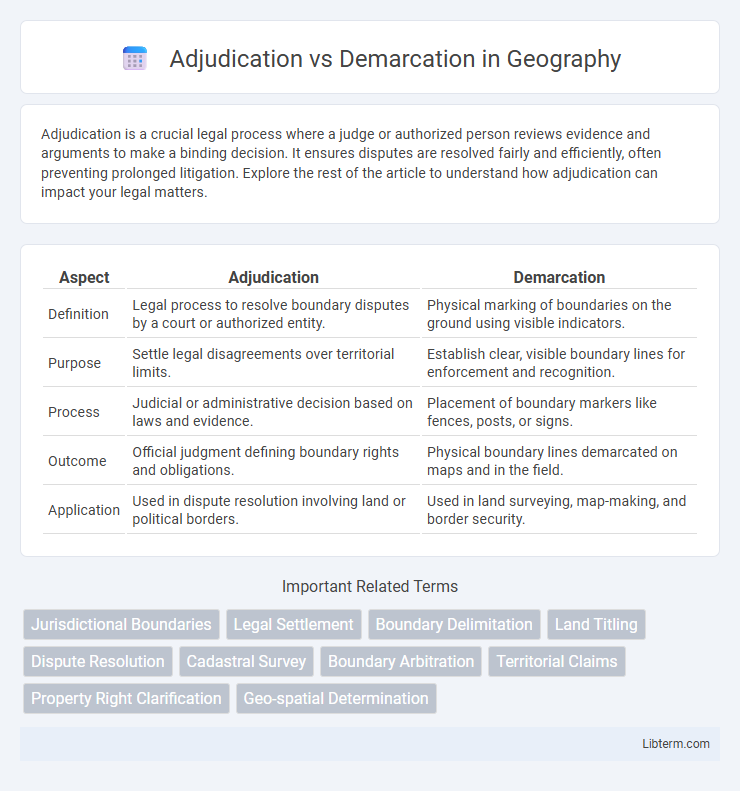Adjudication is a crucial legal process where a judge or authorized person reviews evidence and arguments to make a binding decision. It ensures disputes are resolved fairly and efficiently, often preventing prolonged litigation. Explore the rest of the article to understand how adjudication can impact your legal matters.
Table of Comparison
| Aspect | Adjudication | Demarcation |
|---|---|---|
| Definition | Legal process to resolve boundary disputes by a court or authorized entity. | Physical marking of boundaries on the ground using visible indicators. |
| Purpose | Settle legal disagreements over territorial limits. | Establish clear, visible boundary lines for enforcement and recognition. |
| Process | Judicial or administrative decision based on laws and evidence. | Placement of boundary markers like fences, posts, or signs. |
| Outcome | Official judgment defining boundary rights and obligations. | Physical boundary lines demarcated on maps and in the field. |
| Application | Used in dispute resolution involving land or political borders. | Used in land surveying, map-making, and border security. |
Understanding Adjudication and Demarcation
Understanding adjudication involves recognizing it as a legal process where a judge or authorized official reviews evidence and arguments to make a binding decision, often resolving disputes related to property boundaries or land ownership. Demarcation refers to the physical process of marking or delineating boundaries on the ground, using markers, fences, or natural landmarks to establish clear territorial limits. Both adjudication and demarcation play critical roles in land administration, ensuring legal clarity and preventing boundary conflicts.
Definitions: Adjudication vs Demarcation
Adjudication is a formal legal process where an impartial authority reviews and settles disputes by making a binding decision. Demarcation involves physically marking boundaries or limits, often related to land or jurisdiction areas, without resolving disputes through legal judgment. Understanding the definitions highlights adjudication as a decision-making procedure, whereas demarcation emphasizes territorial or structural boundary establishment.
Core Purpose of Adjudication
Adjudication serves as a formal legal process designed to resolve disputes by delivering a binding decision based on evidence and legal principles. Unlike demarcation, which involves defining boundaries or limits, adjudication's core purpose is to provide impartial judgment and enforce rights or obligations between conflicting parties. This mechanism ensures clarity, fairness, and finality in resolving conflicts within judicial or quasi-judicial frameworks.
Core Purpose of Demarcation
Demarcation primarily serves to establish clear boundaries between different land parcels or administrative zones, preventing disputes and legal ambiguities. It involves physically marking these boundaries on the ground using markers, fences, or signs to provide visible evidence of ownership or jurisdiction. This process ensures clarity and stability in land management by defining exact limits for property or territorial control.
Key Differences between Adjudication and Demarcation
Adjudication involves a legal process where a neutral third party renders a binding decision to resolve disputes, often related to contract or construction claims, emphasizing timely conflict resolution. Demarcation refers to defining and marking boundaries, typically in land or territorial contexts, establishing clear physical or legal limits to prevent overlap or encroachment. Key differences include adjudication's role in dispute resolution through judgment, while demarcation focuses on physically or legally setting boundaries to avoid disputes.
Legal Frameworks Involving Adjudication and Demarcation
Legal frameworks involving adjudication and demarcation are critical in resolving territorial disputes and defining boundaries between states or properties. Adjudication typically refers to the judicial process where courts or tribunals interpret and apply laws to settle disputes based on evidence and legal principles, as seen in international courts like the International Court of Justice (ICJ). Demarcation involves the physical marking of boundaries based on agreements or legal rulings, often following adjudication, and is governed by treaties, national laws, and international protocols to ensure clear and enforceable border definitions.
Processes Involved in Adjudication
Adjudication involves a formal process where a neutral third party reviews evidence, listens to arguments, and makes a legally binding decision to resolve disputes, often used in legal, construction, or administrative contexts. The process typically includes filing a claim, submission of evidence, hearings or presentations, and issuance of a final decision or award. Unlike demarcation, which defines boundaries or limits, adjudication centers on dispute resolution through structured evaluation and judgment.
Processes Involved in Demarcation
Demarcation involves clearly establishing physical boundary lines between properties through a systematic process that includes surveying land, placing markers, and recording geographic coordinates. This process requires collaboration between landowners, surveyors, and local authorities to ensure legal compliance and resolve any overlapping claims. Precise measurement techniques and official documentation play crucial roles in confirming property limits to prevent future disputes.
Common Challenges in Adjudication and Demarcation
Common challenges in adjudication and demarcation processes include ambiguous boundary definitions, conflicting land claims, and insufficient legal documentation. Disputes often arise due to overlapping territorial rights and inconsistent survey data, complicating resolution efforts. Effective resolution requires precise geospatial analysis, clear legal frameworks, and community engagement to address disputes and ensure accurate boundary establishment.
Importance in Land Management and Dispute Resolution
Adjudication and demarcation play crucial roles in land management by establishing clear and legally recognized boundaries, preventing conflicts, and ensuring rightful ownership. Adjudication resolves disputes by officially determining land rights through a judicial or administrative process, while demarcation involves the physical marking of these boundaries on the ground to avoid future misunderstandings. Both processes contribute to sustainable land use, secure property tenure, and effective dispute resolution in land administration systems.
Adjudication Infographic

 libterm.com
libterm.com